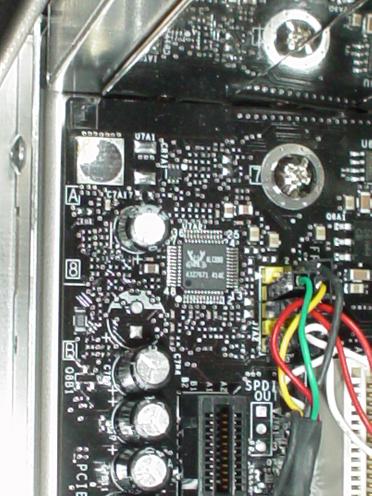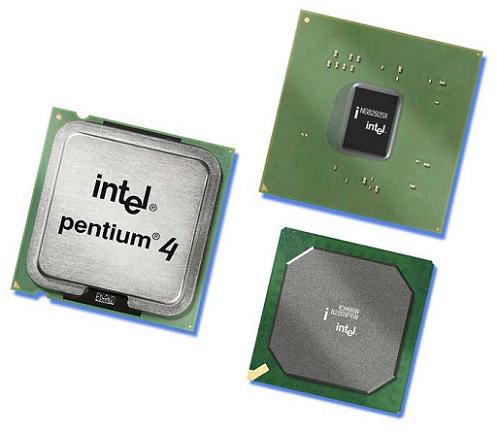Monarch Hornet Pro: "SFF" meets PCI Express, DDR2
by Evan Lieb on July 31, 2004 12:05 AM EST- Posted in
- Systems
Monarch Hornet Pro: Intel D925XBC Motherboard
| Motherboard Specifications | |
| CPU Interface | Socket LGA775 Prescott |
| Chipset | Intel 925X North Bridge (MCH) ICH6R South Bridge |
| CPU Ratios | None |
| Bus Speeds | up to 4% overclocking in 1% increments |
| PCI/PCI-e Speeds | PCI up to 40.00MHz in 3.64MHz increments SATA up to 109.42MHz in 1.32MHz increments |
| Core Voltage | None |
| DRAM Voltage | None |
| AGP Voltage | None |
| Chipset Voltage | None |
| Memory Slots | 4 X 240-pin DDR2 DIMM Slots |
| Expansion Slots | 1 X PCI-e 16x slot 1 X PCI-e 1x slot 2 X PCI (32-bit) slots |
| Onboard SATA/RAID | 4 X SATA150 connectors RAID 0, RAID 1 |
| Onboard IDE | 1 X ATA/100/66 connector (2 devices) |
| Onboard USB 2.0/IEEE-1394 | 8 X USB 2.0 ports (4 rear, 4 internal) 3 X IEEE1394 FireWire (1 rear, 2 internal) |
| Onboard LAN | Intel GbE 10/100/1000 (Marvell PCI Express controller) |
| Onboard Audio | Intel AC'97 8-channel (Realtek ALC880) |
| BIOS Revision | CV92510A.86A.0210 |
Intel's D925XBC motherboard carries a Realtek ALC880 codec, which in conjunction with the ICH6R South Bridge allows Hornet Pro owners to use up to 8-channel audio configurations. The ALC880 is the first HD Audio codec (developed by Intel) we know of being widely implemented onboard high-end motherboards. This is definitely one of the higher quality codecs around, with support for up to 24-bit/192KHz (sampling rate) audio. While it's still quite difficult to maintain close to interference-free audio in a computer case as small as the Hornet Pro (compared to an ATX tower that is), we did hear some static at higher volumes. Still, the ALC880 is a more than acceptable quality codec for everyday users. Even gamers will be quite pleased with this solution, especially considering the surround sound features it supports, namely Dolby Surround EX originally introduced in Star Wards Episode I: The Phantom Menace.
Many enthusiasts consider the chipset the most important part of any computer system. The Hornet Pro's chipset consists of the Intel 925X North Bridge and ICH6R South Bridge. The 925X is Intel's fastest and most advanced North Bridge (also called the "MCH") to date, as is their ICH6R South Bridge. The 925X MCH primarily houses the PCI-e and memory controllers, while the ICH6R controls the storage (SATA, PATA, RAID, etc.), audio, and functionality.
Besides perhaps the platform technology itself (925X, DDR2, PCI-e, etc.), the components that came with our Hornet Pro are the most exciting part of this whole system. Included with our Hornet Pro was a Lite-On 8X dual layer DVD Burner, two Western Digital 74GB 10,000RPM Raptor HDDs (Hard Drive Disks), four 512MB Corsair XMS2 DDR2-533 memory modules, one PCI Express 256MB NVIDIA GeForce 6800 Ultra, and an Intel Pentium 4 550 Prescott processor clocked at 3.4GHz. Except for the fact that Socket 775 platforms are slower on the whole compared to Athlon 64, the rest of this system is right on the bleeding edge of technology and will be thoroughly enjoyed by anyone who decides to purchase it. Just don't be surprised if it costs you more than a few wooden nickels.
One of the reasons it's hard to come to any definitive conclusions about the Monarch Hornet Pro is due to the fact that Intel hasn't released anything faster than a 3.6GHz 800MHz FSB processor for Socket 775 platforms. As we explained in our original Prescott article last month, Prescott doesn't really reach its true potential until beyond 3.6GHz because of its vastly improved architecture over the 0.13-micron Northwood Pentium 4. Therefore, with this type of motherboard socket, you probably aren't going to see significant performance advantages over competitive Athlon 64 processors until around 4GHz or so, maybe higher. And as just reported here on AnandTech recently, it looks as if Intel will delay their introduction of 4GHz processors until the first quarter of next year.












7 Comments
View All Comments
MichelMerlin - Monday, August 2, 2004 - link
What I like in this SFF is its size and according ability to receive more changes than the Shuttle models, for instance big silent GC cooling systems.However the article (excellent otherwise) should tell IMO if the system, as delivered, is silent enough during regular activities (excluding leading edge games but including some ordinary games)
Paris, Mon 2 Aug 2004 09:28:35 +0200
Bonesdad - Saturday, July 31, 2004 - link
Who is the little guy inside the case? Does he make the wheels go round?bupkus - Saturday, July 31, 2004 - link
I like the hybrid approach between the traditional microATX and SFF as it should allow mainboard options unavailable with the SFF.Unfortunately, they only allow the microATX PS which usually comes with a much lower wattage.
Just a broader comment here:
With so much being put on the mainboard I would think fewer people really need all those PCI slots. I for one don't see my ever needing an ATX mainboard when the microATX boards provide all the slots I will need. Smart move by Monarch. I'll be looking for when the prices come down.
Spacecomber - Saturday, July 31, 2004 - link
Oops, I guess you can't edit these notes. I meant to say 10,000 rpm "drives" not fans.While I'm at it, did you notice that this chassis has a removable motherboard tray?
skunkbuster - Saturday, July 31, 2004 - link
to me it just looks kind of generic. i wish they spent some time 'revamping' the exterrior..can't really compare to a shuttle in that aspect..
Spacecomber - Saturday, July 31, 2004 - link
Looks like this motherboard requires a custom I/O shield, which Intel didn't supply?Yeah, I know, I'm being pretty picky.
Thanks for bring these barebones to my attention.
By the way, how did the system hold up with temperatures after running some programs that would heat up the processor, video card, and hard drives? Some idle vs load temp comparisons would have been interesting. If I followed the case description properly, there are two 40mm fans in the back and an 80 mm intake fan in the front (and the P/S, of course) for cooling this system. Do the dual 10,000 rpm fans have enough room to breath? I couldn't quite picture where they are in the case from the photos.
Space
Zepper - Saturday, July 31, 2004 - link
Monarch is a sharp company - just wanted to be the first to post a comment.. Well written article! this type of system is not my cup of tea but monarch has plenty of others to ease that plastic out of your wallet...
.bh.